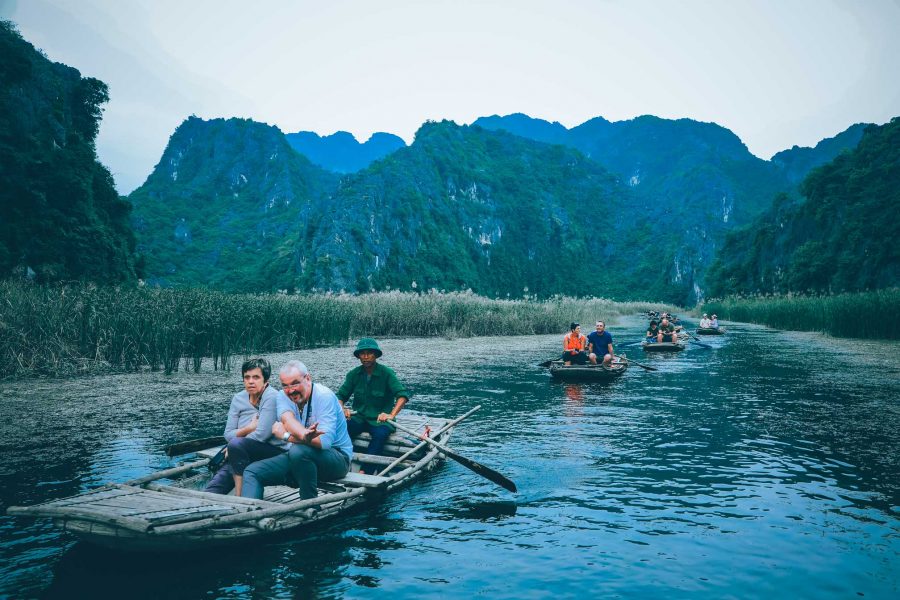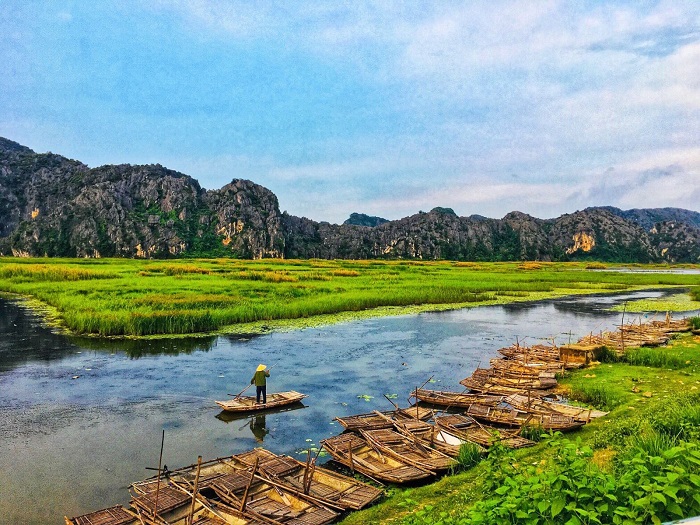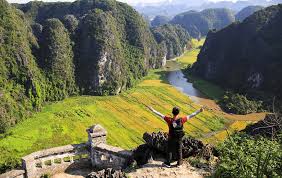Van Long Wetland Nature Reserve – Bay without waves

Coming to Van Long Lagoon, you don’t need to worry about the crowded scene like at Tam Coc or Trang An Wharf. This tourist destination is the largest wetland nature reserve in the Northern Delta, preserving its pristine natural beauty with endless limestone mountains. It is home to many precious and rare flora and fauna species.
Van Long Lagoon has an area of over 3,000 hectares. Like a watercolor painting with limestone mountains reflecting on the clear blue water. Inside this rocky mountain are 32 caves with typical beauty such as Fish Cave, Bong Cave, Turtle Cave, Chanh Cave, and Thung Doi Cave…

The best time to go to Van Long Lagoon is early morning or sunset. Known as the “bay without waves,” sitting on a rustic boat gently floating on the clear blue water, visitors will feel the water surface here is as calm as a giant mirror bestowed by nature. Visitors will be able to take a boat ride through the cool caves, because the water here is clear blue, so sitting on the ship, visitors can see moss, or beautiful algae-like coral reefs, and admire the beautiful coral reefs. Flocks of white storks and flocks of birds fly back to their nests with all kinds of colors blending into the sunset in the afternoon.
Traveling to Van Long Lagoon, enjoying the fresh air, and immersing yourself in the charming landscape of mountains and water will bring a wonderful experience to those souls who dream of traveling, leisurely and freely. Visitors will have the feeling “I am in a very far away place, where there is no noise from the city. In a dreamlike place…”





Van Long Lagoon eco-tourism area is honored to be recognized by the international Ramsar Convention as Vietnam’s 9th Ramsar site (Ramsar Site No. 2360 in the World).
This is the 9th Ramsar site in Vietnam. Van Long Lagoon is recognized as a place with a unique and rich natural landscape of wetlands, possessing a diverse ecosystem that is home to many rare flora and fauna species. Surrounded by limestone mountains with shapes true to their names such as Meo Cao Mountain, Mam Xoi Mountain, Hom Sach Mountain, Da Ban Mountain, Nghien Mountain, Mo Coi Mountain, Co Tien Mountain…
Owns 2 records of the Vietnam Record Book Center: “Place with the largest number of white-rumped langurs” and “Place with the largest natural picture”.
Known as the “bay without waves,” coming to Van Long, visitors have the opportunity to enjoy the comfortable feeling of sitting on a small bamboo boat gliding on the calm, mirror-like water surface, clearly showing the layers of moss below.

In the winter afternoon, leisurely rowing on the clear blue water of the vast lagoon, visitors will be extremely excited if they just wave the oar vigorously, flocks of storks, egrets, teal… are hidden in the grass and trees. The movement will rush away. The long, white wingspans flutter, intertwine, and blend together to create a dance that captivates people’s hearts.
Van Long Lagoon has a rich and unique ecosystem. The isolated limestone mountains in the middle of the lagoon become a shelter for rare animals, among which, not to mention the population of Delacour’s Langur, with a number of more than 40 individuals – the largest in Vietnam today. This is a highly endangered animal, listed in the World Red Book. If you are lucky, you can encounter individual langurs living in rock caves going out looking for food. As for storks, almost every afternoon they fly over the mountains. Mountains with names like Meo Cao Mountain, Mam Xoi Mountain, Hom Sach Mountain, Da Ban Mountain, and Nghien Mountain… still reflect on the calm water surface every day like a giant mirror.


Van Long Lagoon is also home to many landscapes and cultural relics, as many beautiful caves in the mountains such as Fish Cave, Bong Cave, Turtle Cave, and Chanh Cave…, blending with the mountains and clouds to create an amazingly beautiful picture of nature.
The deeper you go into the lagoon, the only space left is the sound of oars and the sounds of birds chirping or the hunting sounds of kingfishers. The boat gently weaves through the grass to take tourists to visit Ca Cave – the largest cave in the Hoang Quyen mountain range. This is the home of many fish species such as catfish, banana fish, and perch… The most suitable time of day to visit Van Long is in the late afternoon. At this time, the sun sets, making the water’s surface sparkle with golden light, creating a feeling of both poetic and peaceful. In the shadow of the sunset that gradually dyes the space of the lagoon, when flocks of foraging birds fly back one after another to find shelter for the night, and also when the silhouettes of bamboo boats taking tourists to the lagoon are gradually decreasing, it is the time Beautiful for photographers who are passionate about wild nature and migratory birds on winter afternoons.



















